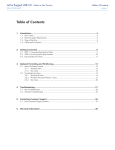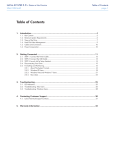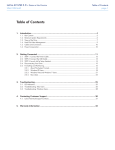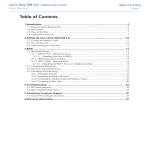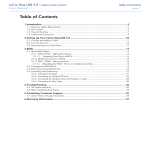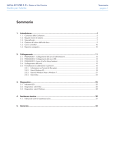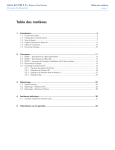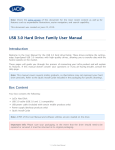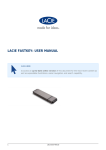Download LaCie 500GB USB3.0 HDD
Transcript
LaCie Rugged USB 3.0 • Design by Neil Poulton User Manual Table of Contents page 1 Table of Contents 1. Introduction................................................................................................................. 4 1.1. 1.2. 1.3. 1.4. Box Content.................................................................................................................................. 5 Minimum System Requirements....................................................................................................... 5 Views of the Drive.......................................................................................................................... 6 Cables and Connectors.................................................................................................................. 7 2. Getting Connected....................................................................................................... 8 2.1. STEP 1: Connecting the Interface Cable ......................................................................................... 9 2.2. STEP 2: Launching LaCie Setup Assistant ...................................................................................... 10 2.3. Disconnecting Your Drive............................................................................................................. 11 3. Optional Formatting and Partitioning......................................................................... 12 3.1. About File System Formats............................................................................................................ 12 3.1.1. Windows Users................................................................................................................ 12 3.1.2. Mac Users...................................................................................................................... 13 3.2. Formatting Instructions................................................................................................................. 14 3.2.1. Windows XP Users........................................................................................................... 14 3.2.2. Windows Vista and Windows 7 Users................................................................................ 17 3.2.3. Mac Users...................................................................................................................... 20 4. Troubleshooting......................................................................................................... 21 4.1. Mac Troubleshooting................................................................................................................... 22 4.2. Windows Troubleshooting............................................................................................................ 24 5. Contacting Customer Support.................................................................................... 26 5.1. LaCie Technical Support Contacts................................................................................................. 27 6. Warranty Information................................................................................................ 28 LaCie Rugged USB 3.0 • Design by Neil Poulton User Manual Copyrights Copyright © 2010 LaCie. All rights reserved. No part of this publication may be reproduced, stored in a retrieval system, or transmitted in any form or by any means, electronic, mechanical, photocopying, recording or otherwise, without the prior written consent of LaCie. Trademarks Apple, Mac, and Macintosh are registered trademarks of Apple Computer, Inc. Microsoft, Windows XP, Windows Vista, and Windows 7 are registered trademarks of Microsoft Corporation. Other trademarks mentioned in this manual are the property of their respective owners. Changes The material in this document is for information only and subject to change without notice. While reasonable efforts have been made in the preparation of this document to assure its accuracy, LaCie assumes no liability resulting from errors or omissions in this document, or from the use of the information contained herein. LaCie reserves the right to make changes or revisions in the product design or the product manual without reservation and without obligation to notify any person of such revisions and changes. Canada Compliance Statement This Class B digital apparatus meets all requirements of the Canadian InterferenceCausing Equipment Regulations. 100409 v1.1 Foreword page 2 FCC Statement Rugged USB 3.0 Tested to comply with FCC standards for home or office use NOTE: This equipment has been tested and found to comply with the limits for a Class B digital device, pursuant to Part 15 of the FCC Rules. These limits are designed to provide reasonable protection against harmful interference in a residential installation. This equipment generates, uses and can radiate radio frequency energy and, if not installed and used in accordance with the instructions, may cause harmful interference to radio communications. However, there is no guarantee that interference will not occur in a particular installation. If this equipment does cause harmful interference to radio or television reception, which can be determined by turning the equipment off and on, the user is encouraged to try and correct the interference by one or more of the following measures: ✦✦ Reorient or relocate the receiving antenna. ✦✦ Increase the separation between the equipment and receiver. ✦✦ Consult the dealer or an experienced radio/TV technician for help. Modifications to this product not authorized by LaCie could void the FCC & Industry Canada regulations and negate your authority to operate the product. Manufacturer’s Declaration for CE Certification We, LaCie, solemnly declare that this product conforms to the following European standards: Class B EN60950, EN55022, EN55024 With reference to the following conditions: 73/23/EEC Low Voltage Directive; 89/336/EEC EMC Directive This symbol on the product or on its packaging indicates that this product must not be disposed of with your other household waste. Instead, it is your responsibility to dispose of your waste equipment by handing it over to a designed collection point for the recycling of waste electrical and electronic equipment. The separate collection and recycling of your waste equipment at the time of disposal will help to conserve natural resources and ensure that it is recycled in a manner that protects human health and the environment. For more information about where you can drop off your waste equipment for recycling, please contact your local city office, your household waste disposal service, or the shop where you purchased the product. LaCie Rugged USB 3.0 • Design by Neil Poulton User Manual Health and Safety Precautions ✦✦ Only qualified persons are authorized to carry out maintenance on this device. ✦✦ Read this User Manual carefully and follow the correct procedure when setting up the device. ✦✦ Do not open a disk drive or attempt to disassemble or modify it. Never insert any metallic object into the drive to avoid any risk of electrical shock, fire, short-circuiting or dangerous emissions. The disk drive shipped with your LaCie Rugged Hard disk contains no user-serviceable parts. If it appears to be malfunctioning, have it inspected by a qualified LaCie Technical Support representative. ✦✦ Never expose your device to rain, or use it near water, or in damp or wet conditions. Never place objects containing liquids on the LaCie Rugged Hard disk, as they may spill into its openings. Doing so increases the risk of electrical shock, short-circuiting, fire or personal injury. ✦✦ Make sure that the computer and LaCie Rugged Hard disk are electrically grounded. If the devices are not grounded, there is an increased risk of electrical shock. Power requirements 100-240 V~, 4A, 60-50 Hz, (Supply voltage fluctuations not exceeding ± 10% of the nominal, transient over-voltages according to over-voltage category II). General Use Precautions ✦✦ Do not expose the LaCie Rugged Hard disk to temperatures outside the range of 5° C to 35 C (41° F to 86° F); or to operational humidity beyond 5-80%, non-condensing, or non-operating humidity beyond 10-90%, non-condensing. Doing so may damage the LaCie Rugged Hard disk or disfigure its casing. Avoid placing your LaCie Rugged Hard disk near a source of heat or exposing it to sunlight (even through a window). Inversely, placing your LaCie Rugged Hard disk in an environment that is too cold or humid may damage the unit. ✦✦ Do not place objects on top of the LaCie Rugged Hard disk or use excessive force on it. ✦✦ Never use excessive force on your LaCie Rugged Hard disk. If you detect a problem, see the Troubleshooting section in this manual. IMPORTANT INFO: Any loss, corruption or destruction of data while using a LaCie drive is the sole responsibility of the user, and under no circumstances will LaCie be held liable for the recovery or restoration of this data. To help prevent the loss of your data, LaCie highly recommends that you keep TWO copies of your data; one copy on your external hard disk, for instance, and a second copy either on your internal hard disk, another external hard disk or some other form of removable storage media. LaCie offers a complete line of CD and DVD drives. If you would like more information on backup, please refer to our website. IMPORTANT INFO: 1GB = 1,000,000,000 bytes. 1TB = 1,000,000,000,000 bytes. Once formatted, the actual available storage capacity varies depending on operating environment (typically 5-10% less). Foreword page 3 LaCie Rugged USB 3.0 • Design by Neil Poulton User Manual 1.Introduction Thank you for purchasing the LaCie Rugged USB 3.0 Hard Disk. This manual will guide you through the process of connecting your drive to your computer and will assist you in troubleshooting any issues that may arise. If you encounter problems, first follow the instructions in the Quick Install Guide, then consult this manual’s chapter on setting up the device. If the problem persists, see the troubleshooting section. If all else fails, check the FAQs for your product at lacie.com/support or consider posting a topic to the forum on lacielounge.com or consulting customer support. Quick Links Click a topic: ✦✦ Getting Connected ✦✦ Optional Formatting and Partitioning ✦✦ Troubleshooting Introduction page 4 LaCie Rugged USB 3.0 • Design by Neil Poulton User Manual Introduction page 5 1.1. Box Content Your box contains the LaCie hard disk and the items listed below: 1. LaCie Rugged All-Terrain Hard Disk 2. USB 3.0 cable (USB 2.0 and 1.1 compatible) 3. USB power cable 4. Quick Install Guide NOTE: The User Manual and software utilities are pre-loaded on the drive. IMPORTANT INFO: Please save your packaging. In the event that the drive should need to be repaired or serviced, it must be returned in its original packaging. 1.2. Minimum System Requirements Your system must meet certain requirements in order for your LaCie product to function properly. For a list of these requirements, please refer to the product packaging or consult the datasheet (at www. lacie.com/support/). Rugged USB 3.0 D E S I G N B Y N E I L P O U LTO N All-Terrain Hard Disk Quick Install Guide LaCie Rugged USB 3.0 • Design by Neil Poulton User Manual Introduction page 6 1.3. Views of the Drive Rear View 1. USB 3.0 port 2. USB power cable port Exploded View Your LaCie Rugged All-Terrain Hard Disk is equipped with an external rubber bumper which encases the aluminum body to protect against drops (7.2 feet/2.2 m or less) and other impacts (Fig. 02). Inside the casing, internal anti-shock bumpers provide and extra measure of protection. Fig. 01 Fig. 02 LaCie Rugged USB 3.0 • Design by Neil Poulton User Manual Introduction page 7 1.4. Cables and Connectors USB 3.0 USB is a serial input/output technology for connecting peripheral devices to a computer or to each other. SuperSpeed USB 3.0 is the latest implementation of this standard, and it provides higher bandwidth and new power management features. Fig. 03 - USB 3.0 Cable Ends Transfer rates can attain up to 4.8 Gbits/s as opposed to USB 2.0’s 480 Mbits/s. This means USB 3.0 is theoretically up to ten times faster than its predecessor (although less in practice). Additionally, improved power management means peripherals will draw less electricity when inactive. Your LaCie drive is shipped with a SuperSpeed USB 3.0 cable to ensure maximum data transfer performance when connected to a compatible USB 3.0 port (Fig. 03). The cable will also work when connected to a USB 2.0 or 1.1 port, but drive performance will be limited to their respective transfer rates. USB Power Cable In the event that the USB bus on your computer does not provide the necessary power to operate your LaCie hard disk, the included USB power cable connects to an available USB port on your computer (Fig. 04). The USB ports (USB 3.0 or USB 2.0) on your computer will help provide power to your LaCie drive. 1. Attach the small end of the USB power cable to the back of your LaCie drive. 2. Attach the USB end of the USB power cable to an available USB port on your computer. Fig. 04 - USB Power Cable Ends LaCie Rugged USB 3.0 • Design by Neil Poulton User Manual 2.Getting Connected Installing the LaCie Rugged hard disk is easy for all users, regardless of operating system, thanks to LaCie Setup Assistant. Install your drive in two easy steps: 2.1. STEP 1: Connecting the Interface Cable 2.2. STEP 2: Launching LaCie Setup Assistant IMPORTANT INFO: Please follow the setup steps in the order they are given to ensure that the LaCie Rugged’s volume mounts correctly on your computer. Getting Connected page 8 LaCie Rugged USB 3.0 • Design by Neil Poulton User Manual Getting Connected page 9 2.1. STEP 1: Connecting the Interface Cable 1. Connect the USB 3.0 cable to the drive and to a USB 3.0 port on your computer. If your computer does not have a USB 3.0 port, you can connect the included USB 3.0 cable to a USB 2.0 port. In this case, file transfers will be limited to USB 2.0 speeds. 2. After a few seconds, the drive will mount in My Computer/Computer (Windows) or on your desktop (Mac). TECHNICAL NOTE: If the USB bus on your computer does not provide the necessary power to operate your LaCie Rugged, disconnect the USB cable, connect the USB power cable to your computer and to the Rugged and then reconnect the USB cable. See section 1.4. Cables and Connectors for more information. Fig. 05 LaCie Rugged USB 3.0 • Design by Neil Poulton User Manual 2.2. STEP 2: Launching LaCie Setup Assistant Before using your drive, LaCie Setup Assistant software must be launched to format your drive. It will: ✦✦ Optimize your drive according to your needs ✦✦ Copy the manual and utilities onto your LaCie hard disk The LaCie Setup Assistant does not prevent you from using your computer’s native disk utility program to format or partition your LaCie drive. Simply follow the Setup Assistant through completion, then use your computer’s native disk utility (Disk Management for Windows or Disk Utility for Mac) to reformat your drive. See section 3. Optional Formatting and Partitioning for more information. To launch LaCie Setup Assistant: Windows users: double click on the LaCie icon in “My Computer” (or in “Computer” for Windows Vista users). Mac users: double click on the “LaCie Setup Assistant” icon which will appear on your desktop. IMPORTANT INFO: If you do not launch LaCie Setup Assistant or if you quit LaCie Setup Assistant after the formatting has begun, your drive will not be ready to use and will require manual formatting. The user manual and utilities will not be available on your drive and will have to be downloaded from the LaCie website: www.lacie.com. Important info: LaCie recommends that you copy the user manual and utilities onto your computer’s internal hard drive or other medium when setup is complete. Getting Connected page 10 LaCie Rugged USB 3.0 • Design by Neil Poulton User Manual Getting Connected page 11 2.3. Disconnecting Your Drive USB external devices feature “plug & play” connectivity, which means that your drive can be connected and disconnected while the computer is running. To prevent failures, however, it is important to follow these steps when disconnecting your LaCie hard disk. Windows XP Users From the System Tray (located in the lower right-hand side of your screen), click the Eject icon (a small green arrow over a hardware image) (Fig. 06). Fig. 06 A message will appear, listing the devices the Eject icon controls (it should say, “Safely remove...”). Click on the LaCie hard disk in this prompt. This message will appear: “Safe to Remove Hardware” (or similar). It is now safe to disconnect the device. Windows Vista & Windows 7 Users From the System Tray (located in the lower right-hand side of your screen) click on the plug icon (note the white check mark inside a green circle) (Fig 07). Fig. 07 A message will appear, detailing the devices that may be safely unmounted. Select Eject for the device you wish to unmount (Fig 08). A message will appear notifying you that it is safe to remove the device. Mac Users Drag the hard drive icon to the trash (Fig 09). (The icon pictured below is a generic USB device icon. Your drive may be represented by an icon that looks like the drive itself.) Fig. 08 When the icon disappears from the desktop, the drive can be disconnected. Fig. 09 LaCie Rugged USB 3.0 • Design by Neil Poulton User Manual Optional Formatting and Partitioning page 12 3.Optional Formatting and Partitioning LaCie Setup Assistant should be run once when you first connect your drive. During this process, the drive will be formatted for your needs. However, if you aborted the process or if you wish to reformat your drive after you’ve completed the Setup Assistant, read this chapter for formatting and partitioning information. See the following pages for formatting instructions. 3.1. About File System Formats 3.1.1. Windows Users FAT 32: FAT is an acronym for File Allocation Table, which dates back to the beginnings of DOS programming. Originally, FAT was only 16 bits, but after the second release of Windows 95 it was upgraded to 32 bits, hence the name FAT 32. In theory, FAT 32 volume sizes can range from less than 1MB all the way to 2TB. It is the native file system of Windows 98 and Windows Me, and is supported by Windows 2000, Windows XP, Windows Vista, and Windows 7. When FAT 32 is used with Windows 2000, Windows XP, Windows Vista, and Windows 7 however, volume size is limited to 32GB (by the Windows partition utility, i.e. Disk Manager), and the individual file size is limited to 4GB. NTFS: This acronym stands for New Technology Filing System, and it is the native file system for Windows NT, Windows 2000, Windows XP and Windows Vista. NTFS offers several features that are not available with FAT 32; i.e. file compression, encryption, permissions, and auditing, as well as the ability to mirror drives and RAID 5 capabilities. The minimum supported volume size for NTFS is 10MB, with a maximum of 2TB when initialized in MBR format or without a limit when initialized in GPT format, with no limit to file size. Volumes created in NTFS can only be directly accessed (not through shares) by Windows NT, Windows 2000, Windows XP, Windows Vista, and Windows 7 without resorting to help from third-party products. Windows File System Formats There are two possible file system format categories for Windows users: NTFS and FAT 32 (MS-DOS). See the table below for more information. Use NTFS if: ...you will be using the drive only with Windows XP, Windows Vista, and/or Windows 7 (performance will generally be greater when compared to FAT 32). This file system is compatible in read only mode with Mac OS 10.3 and higher. Use FAT32 if: ...you will be using your drive with both Windows and Mac. Maximum single file size is 4GB. LaCie Rugged USB 3.0 • Design by Neil Poulton User Manual Optional Formatting and Partitioning page 13 3.1.2. Mac Users You may customize the drive by reformatting and/or partitioning the drive with separate file system formats. For optimal performance in Mac OS environments, format and partition the drive as one large Mac OS Extended volume. Mac OS Extended (HFS+): Mac OS Extended refers to the file system used by Mac OS X. HFS+ represents an optimization of the older HFS file system by using hard disk space more efficiently. With HFS+, you are no longer limited by block size. MS-DOS File System (FAT 32): This is the Microsoft file system, more typically known as FAT 32. This is the file system to use if you are going to be using your LaCie Hard Drive between Macs and Windows operating systems. Mac File System Formats There are two possible file system format categories for Mac users: Mac OS Extended (HFS+) and FAT 32 (MS-DOS). See the table below for more information. Use HFS+ if: ...you will be using the drive on Macs only; performance will generally be greater when compared to FAT 32. This file system is NOT compatible with Windows OS. Use FAT32 if: ...you will be using your drive with both Windows and Mac. Maximum single file size is 4GB. LaCie Rugged USB 3.0 • Design by Neil Poulton User Manual Optional Formatting and Partitioning page 14 3.2. Formatting Instructions 3.2.1. Windows XP Users The steps listed below will help you format and partition your disk drive using Windows XP. For more information on choosing the optimal file format, refer to 3.1. About File System Formats. CAUTION: Following these steps will erase everything from the Rugged hard drive. If you have information that you want to protect or continue to use, back up this information before performing these steps. Fig. 10 1. Make sure the drive is connected to and mounted on the computer. 2. Right-click My Computer and select Manage. 3. From the “Computer Management” window, select Disk Management (located below the Storage group). 4. If the “Initialize and Convert Disk Wizard” window appears, click Cancel. 5. Windows will list the hard drives that are installed on the system. Locate your LaCie hard disk drive (Fig. 10). If there is a red circle with a white line, you must initialize the disk. Right-click the icon to select Initialize. 6. In the rectangular box to the right that says “Unallocated” or lists partitions from a previous format, right-click and select New Partition… 7. On the first page of the New Partition Wizard, click Next (Fig. 11). Fig. 11 8. Select the Primary or Extended option (Fig. 12) ) and click Next. continued on next page... Fig. 12 LaCie Rugged USB 3.0 • Design by Neil Poulton User Manual Optional Formatting and Partitioning page 15 9. Specify the partition size. Please note that FAT32 partitions must be 32GB (32000MB) or smaller. By default, the partition occupies the entire volume (Fig. 13) but you may change the size based upon the working environment. Click Next. 10.Assign a drive letter or mount path (Fig. 14). Click Next . 11.Select the file format for the disk (FAT32 will only appear as an option if the partition is 32GB or less). Once FAT32 or NTFS has been selected (Fig. 15), you have the option to Perform a quick format, which allows for a much faster format. While Disk Management does not check the drive for errors as extensively with a quick format, the option does save time. Click Next. continued on the next page >> Fig. 13 Fig. 14 Fig. 15 LaCie Rugged USB 3.0 • Design by Neil Poulton User Manual Optional Formatting and Partitioning page 16 12.A window appears listing your choices. If all seems well, click Finish to begin the format process (Fig. 16). To make a change, select Back. 13.Your drive’s partition(s) should have a “Healthy” status in the list of drives in Disk Management (Fig. 17). You will also see the drive’s partition(s) in My Computer. The drive is ready for use. Fig. 16 Fig. 17 LaCie Rugged USB 3.0 • Design by Neil Poulton User Manual Optional Formatting and Partitioning page 17 3.2.2. Windows Vista and Windows 7 Users The following steps explain how to format your LaCie hard disk using Windows Vista or Windows 7. CAUTION: Following these steps will erase everything from the Rugged hard drive. If you have information that you want to protect or continue to use, back up this information before performing these steps. 1. Right-click Computer and choose Manage. From the Manage window select Disk Management. 2. From the list of drives in the middle of the Disk Management window, right-click your LaCie hard drive and select New Simple Volume... (Fig. 18). Fig. 18 3. The New Simple Volume Wizard will appear. To continue choose Next> (Fig. 19). 4. This wizard allows you to create volumes, also known as partitions. You can choose to create a single partition or many. Type the size of the partition you want to create in megabytes (MB). For example, a 100GB (gigabyte) partition is 100000MB. If you want to create a FAT32 partition, the size cannot exceed 32GB (32000MB) (Fig. 20). Once you have chosen a partition size, select Next>. continued on the next page>> Fig. 19 Fig. 20 LaCie Rugged USB 3.0 • Design by Neil Poulton User Manual Optional Formatting and Partitioning page 18 5. Assign a drive letter or accept the default (Fig. 21). Select Next>. 6. Choose the file system format for the partition. If the partition size is 32GB or less, the choices will include NTFS and FAT32. Select the format and check Perform a quick format (Fig. 22). Select Next>. IMPORTANT INFO: Please refer to section 3.1. About File System Formats, for a more detailed comparison of the various file system formats. TECHNICAL NOTE: Windows Vista SP1 and Windows 7 offer the exFAT file system, which is not limited to partitions greater than 32GB (Fig. 23). Used primarily with USB flash drives, the exFAT file system overcomes many of the limitations of FAT32. In addition to Windows Vista SP1 and Windows 7, the exFAT file system can work on Windows XP SP2 with a special driver. Since Mac OS support is unstable, sharing your LaCie drive between Windows and Apple operating systems using this file format is discouraged. Fig. 21 continued on the next page>> Fig. 22 Fig. 23 LaCie Rugged USB 3.0 • Design by Neil Poulton User Manual Optional Formatting and Partitioning page 19 7. The last window is a summary of the format options you have just selected. If all looks to be correct, click Finish for the format to begin (Fig. 24). Fig. 24 LaCie Rugged USB 3.0 • Design by Neil Poulton User Manual Optional Formatting and Partitioning page 20 3.2.3. Mac Users CAUTION: Following these steps will erase everything from the Rugged hard drive, including encrypted data. If you have information that you want to protect or continue to use, back up this information before performing these steps. 1. Connect the drive to the power source and to the computer via the interface port. 2. Select Utilities from the Go menu in the Finder menu bar. 3. In the Utilities folder, double-click Disk Utility. 4. The Disk Utility window will open (Fig. 25). Select the volume labeled LaCie Hard Disk from the list of available hard disks on the left side of the window. 5. Select the Partition tab. 6. From the Volume Scheme: menu, choose the number of partitions you want to divide the drive into (Mac OS X gives you the option of dividing the drive into at most 16 partitions). You can adjust the size of each partition using the slide bar between the partitions in the Volume Scheme: area. 7. In the Volume Information section, enter a name for each volume (partition), choose the volume file system format. IMPORTANT INFO: Please refer to section 3.1. About File System Formats, for a more detailed comparison of the various file system formats. 8. Once you have finalized the volume options, click Partition. Click Partition again when the alert message appears to continue. 9. Mac Disk Utility will format and partition the disk according to your settings, and your drive will be ready to use. Fig. 25 LaCie Rugged USB 3.0 • Design by Neil Poulton User Manual 4.Troubleshooting If your LaCie hard disk is not working correctly, please refer to the following troubleshooting topics to determine the source of the problem. If you have gone through all of the topics and your drive still does not work properly, please check the FAQs that are regularly published on our website – www.lacie.com. One of these FAQs may provide an answer to your specific question. You can also visit the downloads page, where the most recent software updates will be available. If you need further assistance, please contact your LaCie reseller or LaCie Customer Support (see section 5. Contacting Customer Support for details). Manual Updates LaCie strives to give you the most up-to-date, comprehensive user manuals available on the market. It is our goal to provide you with a friendly, easy-to-use format that will help you quickly install and utilize the many functions of your new device. If your user manual does not reflect the configuration of the product you purchased, please check our website for the most current version of the user manual. www.lacie.com Troubleshooting page 21 LaCie Rugged USB 3.0 • Design by Neil Poulton User Manual Troubleshooting page 22 4.1. Mac Troubleshooting Problem Question Solution The drive is not running noticeably faster when connected via SuperSpeed USB 3.0. Is the drive connected to a USB port on your computer, or to a USB hub? If your drive is connected to a USB port or hub, this is normal. A SuperSpeed USB 3.0 device can only operate at USB 3.0 performance levels when it is connected directly to a USB 3.0 port or hub. Otherwise, the USB 3.0 device will operate at the slower USB transfer rates. Does your computer or operating system support SuperSpeed USB 3.0? See section 1.2. Minimum System Requirements. Does an icon for the drive appear on the desktop? There should be an icon for the LaCie drive on the desktop. If the drive does not appear, follow the rest of the Troubleshooting tips to isolate the problem. Does your computer’s configuration meet the minimum system requirements for use with this drive? See section 1.2. Minimum System Requirements for more information. Did you follow the correct installation steps for the specific interface and operating system. Review the installation steps in section 2.1. STEP 1: Connecting the Interface Cable and section 2.2. STEP 2: Launching LaCie Setup Assistant. Are both ends of the USB cable firmly attached? Check both ends of the USB cable and make sure that they are fully seated in their respective ports. Try disconnecting the cable, waiting 10 seconds, and then reconnecting it. If the drive is still not recognized, restart your computer and try again. Is the drive receiving sufficient power? If the drive is connected to your computer via USB and does not appear to mount, the drive may not be receiving enough power from the USB bus on your computer. Try connecting the USB power sharing cable as described in section 1.4. Cables and Connectors. Is there a conflict with other device drivers or extensions? Contact LaCie Technical Support for help. Has the drive been formatted? If you do not launch LaCie Setup Assistant or if you quit LaCie Setup Assistant after formatting has begun, your drive will not be ready to use and will require manual formatting. Please see section 3. Optional Formatting and Partitioning. Does your computer’s operating system support the file system? Check your computer’s documentation and see section 3. Optional Formatting and Partitioning. The drive is not recognized by the computer. The drive is not recognized by the computer. continued on the next page>> LaCie Rugged USB 3.0 • Design by Neil Poulton User Manual Troubleshooting page 23 Problem Question Solution Error messages under Mac OS 10.x. Did you get an “Error –50” message while copying to a FAT 32 volume? When copying files or folders from Mac OS 10.x to a FAT 32 volume, certain characters cannot be copied. These characters include, but are not limited to: ? < > / \ : Check your files and folders to ensure that these types of characters are not being used. Did you get an error message telling you that the drive has been disconnected when coming out of sleep mode? Simply ignore this message. The drive will remount to the desktop. LaCie drives conserve power by spinning down when you set your computer to sleep mode, and when the computer is “woken” from sleep, it does not give the drive enough time to spin-up from its sleep mode. The drive is working slowly. Are there other USB devices connected to the same port or hub? Disconnect any other USB devices and see if the drive’s performance increases. Time Machine won’t recognize my drive as compatible. How is your drive formatted? Time Machine is compatible only with disks formatted in HFS+ (journaled), not FAT32. The solution is to reformat the drive (see section 3. Optional Formatting and Partitioning). LaCie Rugged USB 3.0 • Design by Neil Poulton User Manual Troubleshooting page 24 4.2. Windows Troubleshooting Problem Question Solution The drive is not running noticeably faster when connected via SuperSpeed USB 3.0. Is the drive connected to a USB port on your computer, or to a USB hub? If your drive is connected to a USB port or hub, this is normal. A SuperSpeed USB 3.0 device can only operate at USB 3.0 performance levels when it is connected directly to a USB 3.0 port or hub. Otherwise, the USB 3.0 device will operate at the slower USB transfer rates. Is the drive connected to a SuperSpeed USB 3.0 port on your computer? Check to see that the SuperSpeed USB 3.0 drivers for both your host bus adapter and device have been installed correctly. If in doubt, uninstall the drivers and re-install them. Does your computer or operating system support SuperSpeed USB 3.0? See section 1.2. Minimum System Requirements. Is there an icon for the drive in My Computer? Go into My Computer and look for an icon and drive letter assigned to the LaCie drive. If the drive does not appear, follow the rest of the Troubleshooting tips to isolate the problem. Does your computer’s configuration meet the minimum system requirements for use with this drive? See section 1.2. Minimum System Requirements for more information. Is the drive receiving sufficient power? If the drive is connected to your computer via USB and does not appear to mount, the drive may not be receiving enough power from the USB bus on your computer. Try connecting the USB power sharing cable as described in section 1.4. Cables and Connectors. Did you follow the correct installation steps for the specific interface and operating system? Review the installation steps in sections 2.1. STEP 1: Connecting the Interface Cable and 2.2. STEP 2: Launching LaCie Setup Assistant. Are both ends of the USB cable firmly attached? Check both ends of the USB cable and make sure that they are fully seated in their respective ports. Try disconnecting the cable, waiting 10 seconds, and then reconnecting it. If the drive is still not recognized, restart your computer and try again. Is there a conflict with other device drivers or extensions? Contact LaCie Technical Support for help. The drive is not recognized by the computer. continued on the next page>> LaCie Rugged USB 3.0 • Design by Neil Poulton User Manual Troubleshooting page 25 Problem Question Solution The drive is working slowly. Are there other USB devices connected to the same port or hub? Disconnect any other USB devices and see if the drive’s performance increases. The drive turns on and off when you turn your computer on and off. This is normal. Your drive has an autoswitching power feature, which means that if your drive is connected to your computer, turning the computer on will automatically turn the drive on. Likewise, turning the computer off will automatically turn the drive off. LaCie Rugged USB 3.0 • Design by Neil Poulton User Manual 5.Contacting Customer Support Before You Contact Technical Support Read the User Manual and review the Troubleshooting section. Try to isolate the problem. If possible, make the drive the only external device on the CPU, and make sure that all of the cables are correctly and firmly attached. If you have asked yourself all of the pertinent questions in the troubleshooting checklist, and you still can’t get your LaCie drive to work properly, contact us via the contacts on the following page. Before contacting us, make sure that you are in front of your computer and that you have the following information on hand: Information Location 1. LaCie hard disk serial number Located on a sticker at the back of drive or on the original packaging 2. Macintosh/PC model Mac users: Click on the Apple icon in the menu bar and select About This Mac. 3. Operating system version 4. Processor speed 5. Computer memory 6. The brands and models of other internal and external peripherals installed on your computer Windows users: Right click My Computer and select Properties > General. Mac users: Click on the Apple icon in the finder bar and select About This Mac. Select More Info... The Apple System Profiler will launch and will list your internal and external peripherals. Windows users: Right click My Computer and select Properties > Hardware. Contacting Customer Support page 26 LaCie Rugged USB 3.0 • Design by Neil Poulton User Manual Contacting Customer Support page 27 5.1. LaCie Technical Support Contacts LaCie Asia http://www.lacie.com/cn/contact/ LaCie Australia http://www.lacie.com/au/contact/ LaCie Belgium http://www.lacie.com/be/contact/ (Dutch) http://www.lacie.com/befr/contact/ (French) LaCie Brazil http://www.lacie.com/us/contact/ LaCie Canada http://www.lacie.com/ca/contact/ (English) http://www.lacie.com/cafr/contact/ (French) LaCie Denmark http://www.lacie.com/dk/contact/ LaCie Finland http://www.lacie.com/fi/contact/ LaCie France http://www.lacie.com/fr/contact/ LaCie Germany http://www.lacie.com/de/contact/ LaCie Ireland http://www.lacie.com/ie/contact/ LaCie Italy http://www.lacie.com/it/contact/ Japan – Elecom CO., LTD. http://www.lacie.jp/ LaCie Korea http://www.lacie.com/kr/contact/ LaCie Latin America http://www.lacie.com/la/contact/ LaCie Netherlands http://www.lacie.com/nl/contact/ LaCie Norway http://www.lacie.com/no/contact/ LaCie Portugal http://www.lacie.com/pt/contact/ LaCie Singapore http://www.lacie.com/asia/contact/ LaCie Southeast Asia http://www.lacie.com/sea/contact/ LaCie Spain http://www.lacie.com/es/contact/ LaCie Sweden http://www.lacie.com/se/contact/ LaCie Switzerland http://www.lacie.com/ch/contact/ (German) http://www.lacie.com/chfr/contact/ (French) http://www.lacie.com/chit/contact/ (Italian) LaCie UK http://www.lacie.com/uk/contact/ LaCie USA http://www.lacie.com/us/contact/ (English) http://www.lacie.com/uses/contact/ (Spanish) LaCie Grand Export http://www.lacie.com/intl/contact/ LaCie Rugged USB 3.0 • Design by Neil Poulton User Manual Warranty Information page 28 6.Warranty Information LaCie warrants your drive against any defect in material and workmanship, under normal use, for the period designated on your warranty certificate. In the event this product is found to be defective within the warranty period, LaCie will, at its option, repair or replace the defective drive. This warranty is void if: ✦✦ The drive was operated/stored in abnormal use or maintenance conditions; ✦✦ The drive is repaired, modified or altered, unless such repair, modification or alteration is expressly authorized in writing by LaCie; ✦✦ The drive was subjected to abuse, neglect, lightning strike, electrical fault, improper packaging or accident; ✦✦ The drive was installed improperly; ✦✦ The serial number of the drive is defaced or missing; ✦✦ The broken part is a replacement part such as a pickup tray, etc. ✦✦ The tamper seal on the drive casing is broken. LaCie and its suppliers accept no liability for any loss of data during the use of this device, or for any of the problems caused as a result. LaCie will not, under any circumstances, be liable for direct, special or consequential damages such as, but not limited to, damage or loss of property or equipment, loss of profits or revenues, cost of replacement goods, or expense or inconvenience caused by service interruptions. Any loss, corruption or destruction of data while using a LaCie drive is the sole responsibility of the user, and under no circumstances will LaCie be held liable for the recovery or restoration of this data. Under no circumstances will any person be entitled to any sum greater than the purchase price paid for the drive. To obtain warranty service, call LaCie Technical Support. You will be asked to provide your LaCie product’s serial number, and you may be asked to furnish proof of purchase to confirm that the drive is still under warranty. All drives returned to LaCie must be securely packaged in their original box and shipped with postage prepaid. IMPORTANT INFO: Register online for free technical support: www.lacie.com/register




























